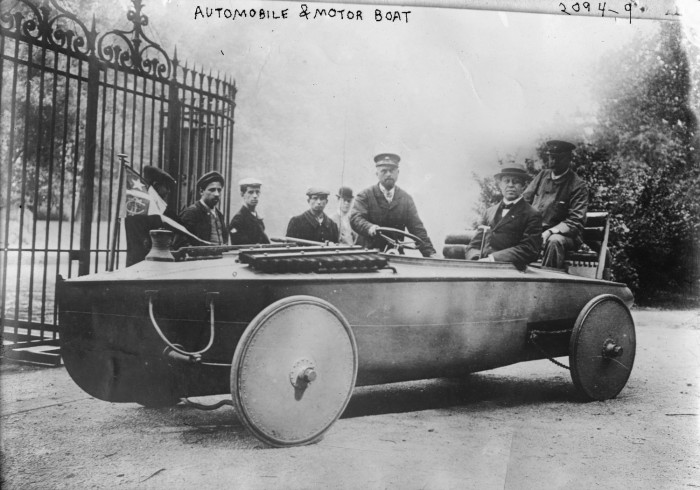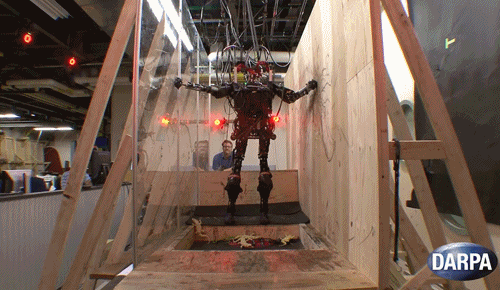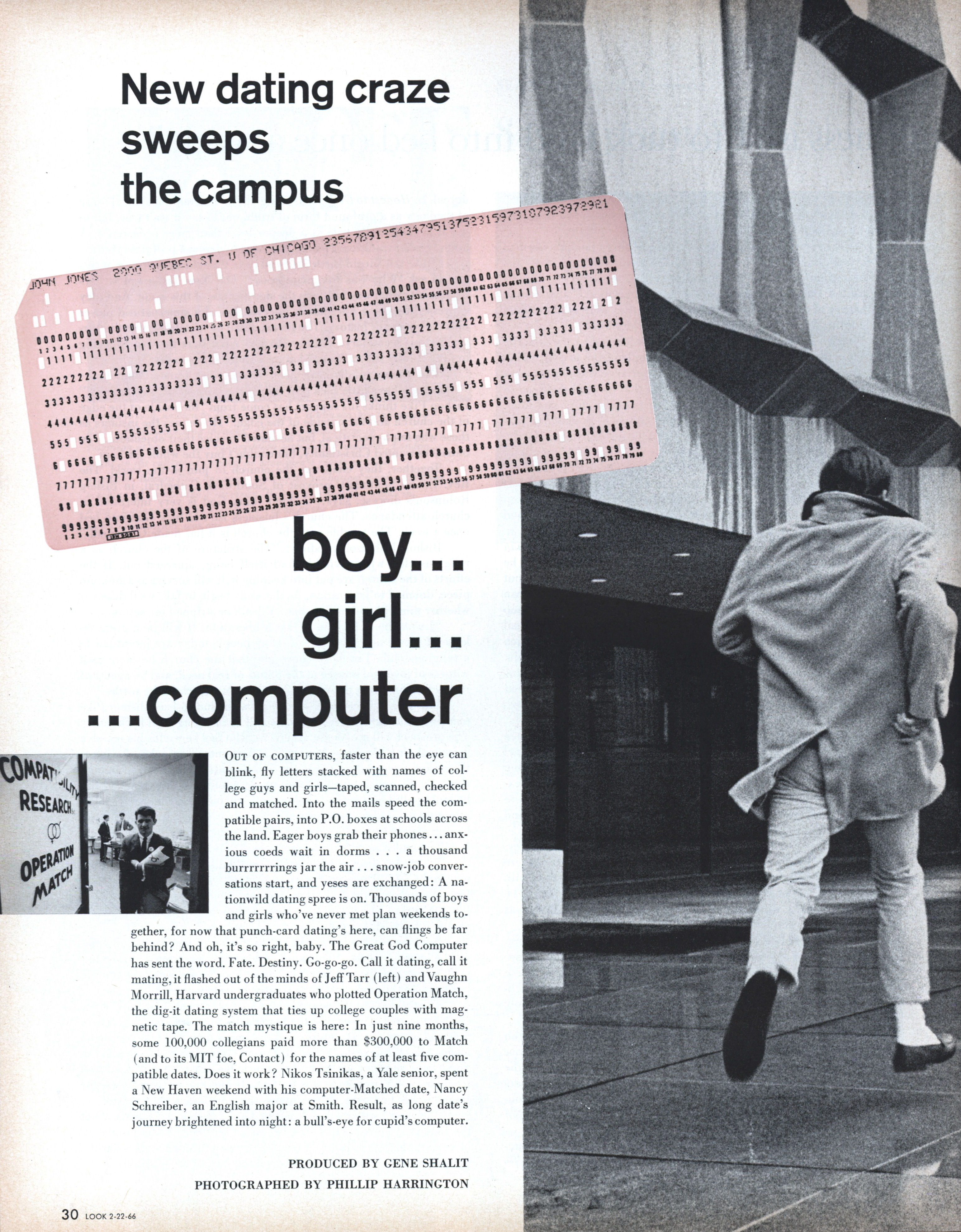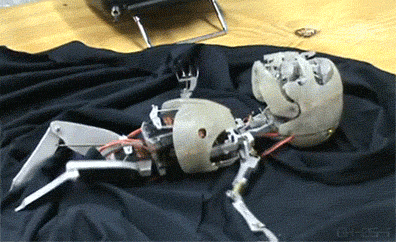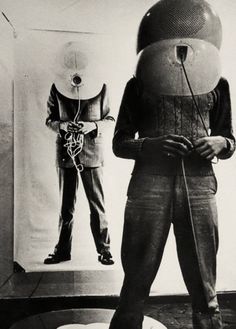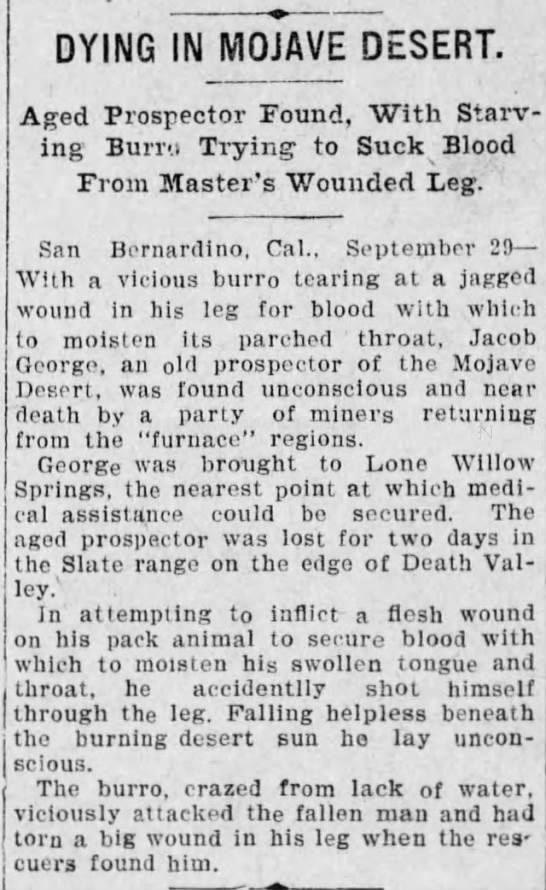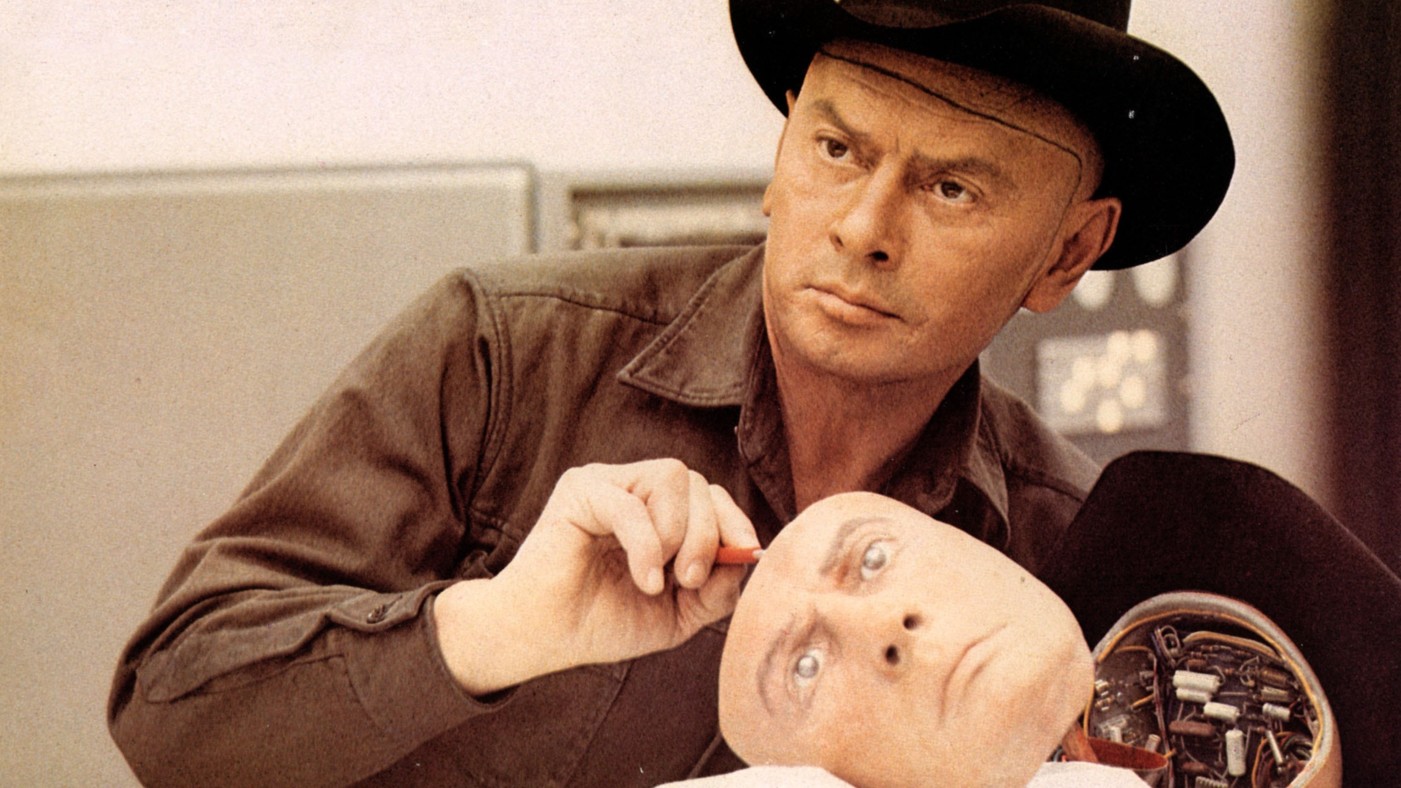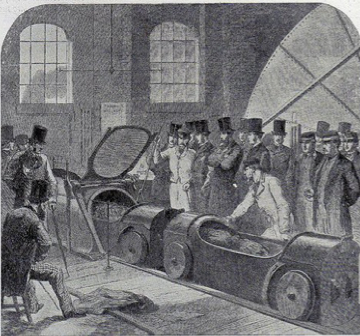That the early 20th-century demonstrations of Waterland, an insane boat-on-wheels by French inventor Jules Reveillier (alternately spelled “Ravaillier” or “Raviller”), were a great success didn’t much matter because there really wasn’t a market for an amphibious automobile. But that doesn’t diminish the wow factor of it all. On November 13, 1907, the New York Times and Brooklyn Daily Eagle filed reports about the outlandish test run in (and around) the Hudson. The Eagle report is attached below.
In his Vice Motherboard article “Marriage Won’t Make Sense When Humans Live for 1,000 Years,” Transhumanist Party Presidential candidate Zoltan Istvan predicts traditional marriage will become obsolete if radical life extension is realized. Well, sure. In fact, reconsiderations of wedlock will occur without far longer lifespans, driven by much simpler technological and sociological changes.
Like many Transhumanists, Istvan is so ebullient about the topic that his timelines for progress are incredibly ambitious, unrealistically so. For instance: I’m willing to wager you won’t be leaving your small child at home with a robot nanny within 15 years.
From Istvan:
Social, financial, and religions pressures aside, the deeper philosophical question of the transhumanist age is: Are people really willing to marry for the rest of their lives when those lives may be hundreds or even thousands of years long? This is especially a pertinent question when it’s almost certain coming technology will allow us to radically change who we are in the near future, both physically and mentally.
In a world of indefinite lifespans, the marriage commitment takes on a whole new meaning and level of commitment.
America and many parts of the developed world are losing their religion, however, which certainly will contribute to less social pushing for matrimony. A recent Pew Research Center study found that many young people increasingly possess no religious leanings at all. In just a few decade’s time, if this statistical trajectory holds, younger generations may broadly prefer not to ever marry.
And who can argue with them? Within 15 years, some of the so-called classic advantages of marriage will be gone. Many people will have robot house nannies, driverless cars, and automated stoves that cook for us. In 20 year’s time, we may also use artificial wombs (ectogenesis) to grow babies, and use our own stem cells to provide genetic treatments to build the perfect child. A spouse will simply not be as necessary in the transhumanist age as it once was.•
Tags: Zoltan Istvan
Remember when Al-Qaeda was the face of modern terror? Ah, the good old days.
One result of the confluence of America’s disastrous war in Iraq and Syria’s destabilization has been the emergence of ISIS, with its beheadings and drownings, all captured with torture-porn film techniques and promoted via social-media campaigns.
In a Spiegel piece, Christoph Reuter interviews the incarcerated ISIS member called Abu Abdullah, the rare member of the terrorist organization captured alive. Abdullah’s chore was to outfit suicide bombers in Baghdad with explosive accessories and coach them in their mission. Quiet time in solitary has not mitigated his madness. An excerpt:
Spiegel:
Did any of the men you accompanied have doubts about their mission?
Abu Abdullah:
No, then they would have failed to carry them out. They were prepared for their assignments for a long time. When they came to me, they were calm, sometimes even joyful. When they put on the belt they would say, for example, “Fits well!” Abu Mohsen Qasimi, a young Syrian, was still making jokes two minutes before his deployment, and then, when he drove off by himself, he bid a friendly farewell. With one young Saudi Arabian, I was wondering how we could inconspicuously change spots, because I was sitting behind the wheel at first. We pretended to have car trouble, both got out and then pushed the vehicle for a bit. Nobody noticed anything. We both laughed.
Spiegel:
You are blushing as you relate that story. Apparently these are pleasant memories. Would you do everything over again?
This is the only moment in the one-and-a-half hour conversation when Abu Abdullah flinches. He turns pale, as though he had been caught red-handed. Then he says that he cannot answer the question.•
Tags: Abu Abdullah, Christoph Reuter
I was reading a BBC article about lethal robots manufactured in South Korea, which are purchased to protect everything from pipelines to airports, and it made reference to a NYT piece I had all but forgotten about, Tim Weiner’s 2005 look at the Pentagon’s desire to robotize its forces. Autonomous soldiers haven’t yet insinuated themselves into our military in a pronounced way, but the research continues apace. Eventually technological capacity will meet desire. From Weiner:
The American military is working on a new generation of soldiers, far different from the army it has.
“They don’t get hungry,” said Gordon Johnson of the Joint Forces Command at the Pentagon. “They’re not afraid. They don’t forget their orders. They don’t care if the guy next to them has just been shot. Will they do a better job than humans? Yes.”
The robot soldier is coming.
The Pentagon predicts that robots will be a major fighting force in the American military in less than a decade, hunting and killing enemies in combat. Robots are a crucial part of the Army’s effort to rebuild itself as a 21st-century fighting force, and a $127 billion project called Future Combat Systems is the biggest military contract in American history.
The military plans to invest tens of billions of dollars in automated armed forces. The costs of that transformation will help drive the Defense Department’s budget up almost 20 percent, from a requested $419.3 billion for next year to $502.3 billion in 2010, excluding the costs of war. The annual costs of buying new weapons is scheduled to rise 52 percent, from $78 billion to $118.6 billion.
Military planners say robot soldiers will think, see and react increasingly like humans. In the beginning, they will be remote-controlled, looking and acting like lethal toy trucks. As the technology develops, they may take many shapes. And as their intelligence grows, so will their autonomy.
The robot soldier has been a dream at the Pentagon for 30 years.•
Tags: Gordon Johnson
It’s difficult to believe that airports, in one way or another, won’t always be a boondoggle, but Scott McCartney of the WSJ envisions a high-tech tomorrow in which commercial fliers will be doted on and waved through by sensors and robots, welcomed and directed via their smart phones and watches. It is likely that airports, like hotels, will have less use for human workers, with holograms perhaps in the intervening period, before the process is barely noticeable.
McCartney’s opening:
Like a good maître d’, the airport of the future will recognize you, greet you by name and know exactly where to put you.
Airports around the world are beginning to move in this direction. At London’s Gatwick Airport, beacons identify you by your smartphone and give GPS-like directions to your gate, pointing out food or shopping along the way. In Germany, robots at Düsseldorf’s airport park your car and return it curbside after you land, linking your itinerary to your license plate. Researchers are developing robots that will be able to check your bags and deliver them within minutes of landing.
Facial-recognition systems speed you through passport control in places including Dulles International Airport near Washington, D.C. Some airports use facial-recognition systems to track your movements around terminals. Gates in some airports are automated with doors that flash open like a subway turnstile when you scan your boarding pass or flash your smartwatch.
At the airport of the future, directional signs will be only for backup. Check-in kiosks will be tucked in a corner. Human agents may be even more unnecessary.•
__________________________
Braniff’s airport of the future, 1975.
Tags: Scott McCartney
I’ve already posted about Johann-Dietrich Woerner, the new General Director of the European Space Agency, who wants to colonize the moon and use that perch to further explore space. Of all the settlement schemes floating around the stratosphere right now, this one seems to me to be the best and most pragmatic. If we’re going to build colonies in space, the moon should probably be first. More from Richard Hollingham at the BBC:
There are good reasons, he says, for going back to the Moon for science as well as using it a stepping-stone to further human exploration of the Solar System.
“The far side of the Moon is very interesting because we could have telescopes looking deep into the Universe, we could do lunar science on the Moon and the international aspect is very special,” he explains. “The Americans are looking to go to Mars very soon – and I don’t see how we can do that – before going to Mars we should test what we could do on Mars on the Moon.”
For example, Woerner suggests, the technology being investigated by Nasa to construct a Mars base using a giant 3D printer would be better tried out on the Moon first. Learning to live on an alien world is going to be tough – but the challenge would be a lot easier, particularly in an emergency, if the extraterrestrial community is only four days away from Earth rather than six months.
Woerner envisages his Moon village as a multinational settlement involving astronauts, Russian cosmonauts and maybe even Chinese taikonauts.•
Tags: Johann-Dietrich Woerner, Johann-Dietrich Wörner, Richard Hollingham
Make a case for ridesharing as a means to greater convenience or to reduce pollution or to (potentially) disrupt racial profiling, but do not make one based on jobs. Uber has squeezed its drivers and made it clear it would love to be rid of them entirely. Uber is about Uber, not about Labor.
Worse yet is making a case for Uber as a friend of workers by invoking the name of Eric Garner, the African-American man selling loose cigarettes who was choked to death in NYC by police in 2014, as Gerald Seabrooks, a Brooklyn bishop, did this week at a Harlem press event organized by Travis Kalanick’s outfit. Saying that Uber having its way in NYC could have prevented that tragedy is every bit as offensive and untrue as is Kalanick using military veterans as a prop for PR purposes.
From Kelly Weill at Capital New York:
Gerald Seabrooks, a Brooklyn-based bishop, said increased employment opportunities would be a boon to minority communities.
“If [Eric] Garner had a job, today he would be alive,” Seabrooks said. “We’re talking economics here. We’re talking jobs.”
But Uber’s reputation isn’t necessarily progressive. The company has come under fire for taking large commissions from drivers’ paychecks, and for fighting to classify drivers as contract workers, rather than employees entitled to benefits.
De Blasio’s own administration has also accused for-hire companies like Uber of prioritizing the wealthy over the working class.
“What it boils down to is this,” taxi commissioner Meera Joshi said in June. “At some point, I strongly believe the city needs to step in and make sure that there is a balance between those of us who choose instant gratification and convenience of travel with private vehicles and the much larger group who cannot afford private car service.”•
Tags: Gerald Seabrooks, Kelly Weill
In addition to being among the best novels ever written in English, Lolita, Vladimir Nabokov’s story of monstrous love, is, shockingly, the Great American Novel, which at first blush seems absurd. How did a newcomer, who had just begun experiencing the country, process so much so soon, so that he could write a work that was of us yet was also able to brutally satirize us? Perhaps it took an immigrant with wide eyes to truly see our immigrant nation.
From John Colapinto in the New Yorker:
Lolita was not, however, Nabokov’s first attempt to write a story about a pedophile who, enamored of a particular twelve-year-old girl, marries her mother to be closer to his love object—and who finds the girl in his clutches after the mother’s untimely death. His first attempt, a short novella called The Enchanter was written in Russian shortly before his move to America. That novella, published posthumously, in 1986, by Vera and Dmitri Nabokov, shows just how important the atmosphere of America was to making Lolita the great work it is. Where The Enchanter is curiously dour, featureless, and vague, Lolita is a great, rollicking encyclopedia teeming with specific details of Nabokov’s adoptive country, sweeping into its embrace the entire American geography, from East to West, North to South, in Humbert’s zig-zagging car journeys with his under-aged sex slave (journeys that follow the same route as the decidedly more sedate butterfly-hunting trips that Nabokov made each summer with his wife).
Much of the novel’s energy derives from the love-hate relationship Nabokov had with America’s postwar culture of crap TV shows, bad westerns, squawking jukeboxes—the invigorating trash that informs the story of a cultured European’s sexual obsession with an American bobby-soxer who is, as Humbert calls her, the “ideal consumer, the subject and object of every foul poster.” Nabokov always refused the label of satirist, and it would be an oversimplification to say that Lolita merely skewers the materialism of fifties America; throughout the book, there is a sense of hypnotized wonder and delight at the happy consumerism of the country and its inhabitants, and Nabokov took overt joy at clipping and cataloguing examples of that consumerism, which he carefully worked into the very texture of Lolita.•
See also:
Tags: John Colapinto, Vladimir Nabokov
Gene Shalit, who once hiccupped and broke his mustache, was apparently busy “producing” articles for Look magazine before he became famous for saying words about movies. In an interesting 1966 piece, “boy…girl…computer,” he writes about punchcard dating invading Harvard and other campuses in those happier times before Mark Zuckerberg was born. (Canadians had experimented with computer dating a decade earlier.) The opening of Shalit’s New Journalism stylings for the long-defunct title:
Out of computers, faster than the eye can blink, fly letters stacked with names of college guys and girls–taped, scanned, checked and matched. Into the mails speed the compatible pairs, into P.O. boxes at schools across the land. Eager boys grab their phones… anxious coeds wait in dorms … a thousand burrrrrrrings jar the air . . . snow-job conversations start, and yeses are exchanged: A nationwild dating spree is on. Thousands of boys and girls who’ve never met plan weekends together, for now that punch-card dating’s here, can flings be far behind? And oh, it’s so right, baby. The Great God Computer has sent the word. Fate. Destiny. Go-go-go. Call it dating, call it mating, it flashed out of the minds of Jeff Tarr (left) and Vaughn Morrill, Harvard undergraduates who plotted Operation Match, the dig-it dating system that ties up college couples with magnetic tape. The match mystique is here: In just nine months, some 100,000 collegians paid more than $300,000 to Match (and to its MIT foe, Contact) for the names of at least five compatible dates. Does it work? Nikos Tsinikas, a Yale senior, spent a New Haven weekend with his computer-Matched date, Nancy Schreiber, an English major at Smith. Result, as long date’s journey brightened into night: a bull’s-eye for cupid’s computer.
“How come you’re still single? Don’t you know any nice computers?”
Perhaps no mother has yet said that to her daughter, but don’t bet it won’t happen, because Big Matchmaker is watching you. From Boston to Berkeley, computer dates are sweeping the campus, replacing old-fashioned boy-meets-girl devices; punch bowls are out, punch cards are in.
The boys who put data in dating are Jeff Tarr and Vaughn Morrill, Harvard undergraduates. At school last winter, they and several other juniors–“long on ingenuity but short on ingenues”–devised a computer process to match boys with girls of similar characteristics. They formed a corporation (Morrill soon sold out to Tarr), called the scheme Operation Match, flooded nearby schools with personality questionnaires to be filled out, and waited for the response.
They didn’t wait long: 8,000 answer sheets piled in, each accompanied by the three-dollar fee. Of every 100 applicants, 52 were girls. Clearly, the lads weren’t the only lonely collegians in New England. As dates were made, much of the loneliness vanished, for many found that their dates were indeed compatible. Through a complex system of two-way matching, the computer does not pair a boy with his ‘ideal’ girl unless he is also the girl’s ‘ideal’ boy. Students were so enthusiastic about this cross-check that they not only answered the 135 questions (Examples: Is extensive sexual activity [in] preparation for marriage, part of “growing up?” Do you believe in a God who answers prayer?), they even added comments and special instructions. Yale: “Please do not fold, bend or spindle my date.” Vassar: “Where, O where is Superman?” Dartmouth: “No dogs please! Have mercy!” Harvard: “Have you any buxom blondes who like poetry?” Mount Holyoke: “None of those dancing bears from Amherst.” Williams: “This is the greatest excuse for calling up a strange girl that I’ve ever heard.” Sarah Lawrence: “Help!”
Elated, Tarr rented a middling-capacity computer for $100 an hour (“I couldn’t swing the million to buy it.”), fed in the coded punch cards (“When guys said we sent them some hot numbers, they meant it literally.”) and sped the names of computer-picked dates to students all over New England. By summer, Operation Match was attracting applications from coast to coast, the staff had grown to a dozen, and Tarr had tied up with Data Network, a Wall St. firm that provided working capital and technical assistance.
In just nine months, some 90,000 applications had been received, $270,000 grossed and the road to romance strewn with guys, girls and gaffes.
A Vassarite who was sent the names of other girls demanded $20 for defamation of character. A Radcliffe senior, getting into the spirit of things, telephoned a girl on her list and said cheerfully, “I hear you’re my ideal date.” At Stanford, a coed was matched with her roommate’s fiance. Girls get brothers. Couples going steady apply, just for reassurance. When a Pembroke College freshman was paired with her former boyfriend, she began seeing him again. “Maybe the computer knows something that I don’t know,” she said.
Not everyone gets what he expects. For some, there is an embarrassment of witches, but others find agreeable surprises. A Northwestern University junior reported: “The girl you sent me didn’t have much upstairs, but what a staircase!”
Match, now graduated to an IBM 7094, guarantees five names to each applicant, but occasionally, a response sets cupid aquiver. Amy Fiedler, 18, blue-eyed, blonde Vassar sophomore, got 112 names. There wasn’t time to date them all before the semester ended, so many called her at her home in New York. “We had the horrors here for a couple of weeks,” her mother says laughingly. “One boy applied under two different names, and he showed up at our house twice!”
Tarr acknowledges that there are goofs, but he remains carefree. “You can’t get hung up about every complaint,” says Tarr. “You’ve got to look at it existentially.”
Jeff, 5′ 7″, likes girls, dates often. “If there’s some chick I’m dying to go out with,” he says, “I can drop her a note in my capacity as president of Match and say, Dear Joan, You have been selected by a highly personal process called Random Sampling to be interviewed extensively by myself. . . . and Tarr breaks into ingratiating laughter.
“Some romanticists complain that we’re too commercial,” he says. “But we’re not trying to take the love out of love; we’re just trying to make it more efficient. We supply everything but the spark.”•
We might already be smart enough to allow the continued survival of our species, but I wouldn’t bet on it. Homo sapiens will ultimately need to engineer evolution if we are to continue to thrive (though that new IQ better also be matched to improved ethics). Of course, our species with dramatically improved intelligence will no longer exactly be our species, but that’s not the worst thing.
In a Washington Post piece, UCLA Law Professor Eugene Volokh skillfully lays out the future, arguing that the path to tomorrow won’t be blocked by the reported 83% of Americans who currently think manipulating a baby’s genes for greater intelligence is wrong. It’s scary to think of such procedures at the moment, but eventually the moment will be different. An excerpt about designer babies and geopolitics:
Intelligence is, generally speaking, good, and more is, generally speaking, better. It’s better for the person in question. It’s better for society to have more intelligent people. It’s not the most important thing. But ask yourself: All else being equal, would you rather have your child have an IQ (for all the limitations of that measure) of 85, 100, 115 or 130?
So here’s how it will happen. Say the 83 percent poll results hold, even once safe genetic modification is available (it’s not clear they will, given that at this point they reflect a purely hypothetical question, but say they do), and Congress bans such modification. Or say there is worry — understandable when it comes to a new technology — that the modification won’t be safe and will cause the birth of children with various birth defects or other problems, so Congress bans it because of that.
Now it’s gone! No more of this awful technology. Except, wait: Say the Chinese don’t see things the way we do. Out come some number of babies with horrible birth defects (truly a tragedy, and as a purely ethical matter, possibly a reason against such experimentation; I’m just saying the ethics won’t matter much). And then things get worked out, and now the new generation of Chinese, or Japanese, or Russians becomes on average much smarter than the new generation of Americans. How long will American public opinion remain opposed to a technology that seems vital to national success, and perhaps even national independence?•
Tags: Eugene Volokh
I posted in January about a fully roboticized Japanese hotel that was in development. The “Henn na” (known as the “Weird Hotel” to the rest of the world) is now opening for business. While the Jurassic Era front-desk clerk will no doubt be an amusing distraction, the lodging is a serious step to disappearing as many people as possible from employment in the hotel industry, to turning human workers into dinosaurs. So far in the U.S., we’ve thus far seen baby steps in that direction. From Yuri Kageyama at the Associated Press:
The receptionist robot that speaks in English is a vicious-looking dinosaur, and the one that speaks Japanese is a female humanoid with blinking lashes. “If you want to check in, push one,” the dinosaur says. The visitor still has to punch a button on the desk, and type in information on a touch panel screen.
Henn na Hotel, as it is called in Japanese, was shown to reporters Wednesday, complete with robot demonstrations, ahead of its opening to the public Friday.
Another feature of the hotel is the use of facial recognition technology, instead of the standard electronic keys, by registering the digital image of the guest’s face during check-in.
The reason? Robots aren’t good at finding keys, if people happen to lose them.
A giant robotic arm, usually seen in manufacturing, is encased in glass quarters in the corner of the lobby. It lifts one of the boxes stacked into the wall and puts it out through a space in the glass, where a guest can place an item in it, to use as a locker.
The arm will put the box back into the wall, until the guest wants it again. The system is called “robot cloak room.”
Why a simple coin locker won’t do isn’t the point.
“I wanted to highlight innovation,” Sawada told reporters. “I also wanted to do something about hotel prices going up.”•
Tags: Yuri Kageyama
Steven Pinker has argued, pretty persuasively, that humankind is less violent than ever before. If so, that’s a real sign of human progress. But what about the wars waged within, the kind that know no detente without intervention?
Mental illness is detected now more than ever, and there are logical reasons for that–greater awareness and diagnosis, longer lifespans–but it also often seems like a mismatch disease of modern life, and one influenced by our technological epoch. In smart Economist essay “The Age of Unreason,” John Prideaux thinks through the received wisdom of a link between mental illness and economic development and also wonders if a small Belgian town’s treatment of those with disorders holds lessons for the rest of the world. An excerpt:
The statistical relationship between mental illness and development is new evidence for an old theory. Since the 19th century, people have been arguing that mental illness is a price to be paid for progress. In Civilisation and its Discontents, Sigmund Freud popularised the notion that neurosis increased in tandem with profit. Before Freud, an American neurologist, George Beard, had noted that a nervous disorder he labelled neurasthenia (and others nicknamed “Americanitis”) was on the rise. He put it down to the speeding up of modern life, facilitated by the telegraph, the railway and the press.
Neurasthenia disappeared from the psychiatrist’s lexicon in 20th-century America but enjoyed a long afterlife in China; Chairman Mao himself was said to suffer from the condition. It faded from view only after Arthur Kleinman, a Harvard anthropologist, conducted fieldwork in China in the 1980s and concluded that the symptoms of neurasthenia were rather like those of depression. Drug companies spied an opportunity to sell pills that they were already making. Rates of diagnosis for depression, which was virtually unknown in China 20 years ago, are now catching up with those elsewhere.
This is not because economic progress, of which China has seen more than any other country over the past three decades, makes people sick. Rather, it is due to a combination of the profound effect that growing richer has on diagnosis and the less forgiving standards for normal behaviour set by modern service-sector jobs. Dealing directly with customers makes different demands on the brain from work in a factory or on the land.
Surveys suggest that the incidence of serious mental illnesses such as schizophrenia (a condition characterised by hearing voices and withdrawal from society) and bipolar disorder (which causes extreme, uncontrollable mood swings) is fairly constant at between 1.5% and 3% of the population around the world.•
Tags: John Prideaux
It’s merely 50 years since commercial aviation truly took off, as only one-fifth of Americans had ever flown in a plane by 1965. Now, of course, flying is a routine transportation, one we can’t imagine living without. But that’s what the latest edition of Gizmodo’s Meanwhile in the Future does, wondering how life would transform if environmental damage made it so that in 2061 we were in a “world without commercial air travel,” except for special cases of urgent individual need (e.g., transport to a funeral or humanitarian mission). Host Rose Eveleth questions sci-fi writer Kim Stanley Robinson and University of Kentucky geography professor Matthew Zook about what this new normal would look like. The latter guest is the one who compares a flightless tomorrow to postwar America if that place and time had been wired. Robinson, meanwhile, wonders if gigantic ships would become itinerant cities.
It’s an interesting thought experiment, in part because it’s such an unlikely scenario that we would try to ward off the Sixth Extinction in this manner. Eveleth quotes 5% as the amount of the carbon footprint caused by aviation (though that’s all flying and not just the commercial kind). Since meat production is responsible for about three-and-a-half times that amount of carbon, it would be a lot simpler to just create in vitro substitutes. Especially since less flying would mean more travel by other environmentally unfriendly vehicles.
Still, a very fun show. Listen here.
Tags: Matthew Zook, Rose Eveleth
In 1752, according to Benjamin Franklin’s Pennsylvania newspaper, a woman wed while naked, and though the details make the whole thing sound like an extended New Jersey joke, it apparently occurred. The topic was dear to the Founding Father’s heart since he was a devout nudist himself, given to a half hour of clothesless writing or reading each morning. I also recall reading (I believe in one version of The Book of Lists) that he participated in orgies in which the men dressed as priests and the women nuns. I can neither confirm nor deny such a thing. The following article from the July 7, 1934 Brooklyn Daily Eagle recalls the naughty nuptials.
Tags: Benjamin Franklin\
I have a fetish
I’m having a bad day and if someone could just give me a ring and call me a beautiful unicorn. It would make my day. I don’t ask my real life friends because I know it’s weird. Feel free to call me anonymously. Just call me a “beautiful unicorn” and describe what I look like and it’ll really turn me on.
Entertainment heavyweight Jerry Weintraub, who passed away earlier this month, was a collector of people, especially those with extraordinary talent or power. He seemed to worship access, which is always a dicey quality to possess. In 1982, when the agent was at the height of his career, a 44-year-old Hollywood megawatt whose light shone everywhere from the White House to Graceland, Weintraub was profiled by Kathy Mackay for People. The opening:
“I love going to the White House,” Jerry Weintraub says. “I get tears in my eyes every time I walk into the Oval Office. It’s awesome. You think, ‘How many people in the world get a chance to shake hands with the President and Vice-President and talk to them?’ Listen, I cry when I hear Hail to the Chief.”
No one who knows the showbiz superagent could doubt for a millisecond the sincerity of those tears welling in Jerry Weintraub’s eyes. Some 20 years ago Weintraub was a kid sorting mail at the William Morris Agency in Manhattan. He overheard two MCA executives discussing an opening for a talent agent. He applied for the job and got it. Today Weintraub, 44, is one of the most powerful figures in the entertainment industry. An elegantly dressed impresario of the glittery and the glamorous, he is also Hollywood’s Washington connection in the Reagan Administration.
Weintraub knows everyone. As a personal manager he runs an incredible musical stable: John Denver, Bob Dylan, Neil Diamond, John Davidson, Wayne Newton, the Beach Boys, the Moody Blues and the Carpenters. He has produced more than 50 concerts for Frank Sinatra. His credits as a movie producer include Nashville and Oh, God! As a political kingmaker, he has raised millions for candidates ranging from JFK to George Bush. “Every door in this business is open to me,” Weintraub says without exaggeration, “because people know I get things done.”
Weintraub in motion—and he is always in motion—is a wonder. His 10-hour days begin on the phone in his chauffeur-driven Rolls en route from his Malibu home to his office in Beverly Hills. His newest projects are a Broadway musical—Weintraub’s first—about the life of Jimmy Durante and a sequel to his latest movie, Diner, about a place where college kids hang out. Diner will be released early this year.
Weintraub’s determination is legendary. His wife, retired 1950s torch singer Jane Morgan, recalls that in the mid-’60s he called Col. Tom Parker nearly every day for a year, begging to promote Elvis. Finally Parker agreed—but only if Weintraub hand-delivered a $1 million check to the colonel’s Las Vegas office the next day. Weintraub did, and Presley became one of his biggest clients. Since then the stars have come to Weintraub. Six years ago Dylan called Jerry up on a Sunday morning and asked him to be his manager. The Carpenters chose him because, Richard Carpenter recalls, “we heard Jerry was somebody who actually molded careers—like Brian Epstein did with the Beatles.”
Weintraub’s detractors credit his rise to sheer chutzpah, plus the ability to make financial offers no one can refuse. “People like me invest time and money in an unknown act,” fumes promoter Jim Rissmiller. “Weintraub comes along and steals them away. I worked with the Bee Gees for seven years, until they did Saturday Night Fever. Then Weintraub offered them the moon to do a national tour.”•
Tags: Jerry Weintraub, Kathy Mackay
At the Singularity Hub, Peter Diamandis has published “The World in 2025: 8 Predictions for the Next 10 Years,” an excited, perhaps excitable, look at technology in a decade. I’ve excerpted two prognostications below. On the first one, a “world of perfect knowledge,” I agree that more information is better in many ways, but people still have a stubborn tendency to see what they want to see regardless of data. On the second one, I think the futurist is too ambitious in thinking digital personal assistants on a ubiquitous scale will be here in a few years. In both cases, the problem of surveillance by governments and corporations is a real issue.
The excerpt:
3. Perfect Knowledge
We’re heading towards a world of perfect knowledge. With a trillion sensors gathering data everywhere (autonomous cars, satellite systems, drones, wearables, cameras), you’ll be able to know anything you want, anytime, anywhere, and query that data for answers and insights.
7. Early Days of JARVIS
Artificial intelligence research will make strides in the next decade. If you think Siri is useful now, the next decade’s generation of Siri will be much more like JARVIS from Iron Man, with expanded capabilities to understand and answer. Companies like IBM Watson, DeepMind and Vicarious continue to hunker down and develop next-generation AI systems. In a decade, it will be normal for you to give your AI access to listen to all of your conversations, read your emails and scan your biometric data because the upside and convenience will be so immense.•
Tags: Peter Diamandis
In his new London Review of Books piece, Slavoj Žižek argues that “China is full of antagonisms and barely controlled instabilities that continually threaten to explode.” Maybe. It’s certainly the largest experiment in world history in its mélange of capitalism, communism, nationalism and authoritarianism. Can the centre hold? Does its relative cultural seclusion from the larger world ultimately support or damn the whole enterprise? An excerpt:
Everyone can be a socialist today, even Bill Gates: it suffices to profess the need for some kind of harmonious social unity, for a common good and for the care of the poor and downtrodden. As Otto Weininger put it more than a hundred years ago, socialism is Aryan and communism is Jewish.
An exemplary case of today’s ‘socialism’ is China, where the Communist Party is engaged in a campaign of self-legitimisation which promotes three theses: 1) Communist Party rule alone can guarantee successful capitalism; 2) the rule of the atheist Communist Party alone can guarantee authentic religious freedom; and 3) continuing Communist Party rule alone can guarantee that China will be a society of Confucian conservative values (social harmony, patriotism, moral order). These aren’t simply nonsensical paradoxes. The reasoning might go as follows: 1) without the party’s stabilising power, capitalist development would explode into a chaos of riots and protests; 2) religious factional struggles would disturb social stability; and 3) unbridled hedonist individualism would corrode social harmony. The third point is crucial, since what lies in the background is a fear of the corrosive influence of Western ‘universal values’: freedom, democracy, human rights and hedonist individualism. The ultimate enemy is not capitalism as such but the rootless Western culture threatening China through the free flow of the internet. It must be fought with Chinese patriotism; even religion should be ‘sinicised’ to ensure social stability. A Communist Party official in Xinjiang, Zhang Chunxian, said recently that while ‘hostile forces’ are stepping up their infiltration, religions must work under socialism to serve economic development, social harmony, ethnic unity and the unification of the country: ‘Only when one is a good citizen can one be a good believer.’•
Tags: Slavoj Žižek
Profusion CEO Mike Weston has written a WSJ article which tries to think ahead of the problems that will arrive when cities have been smartened up. The main issue he examines is marketers purchasing information to target citizens with products. Weston suggests we can tackle the issue with stringent legislation and/or business ethics, but I wonder if those tactics will work. The legislative approach will, at best, be a leaky boat, as it’s likely that this type of information wants to be free–as in liberated. Laws will always likely trail the technology. Expecting businesses to be constrained by a code that runs counter to the bottom line seems unlikely. But it’s good people devoted to data science like Weston are thinking in advance of these developments, and his piece is well worth reading. An excerpt:
By analyzing this information using data-science techniques, a company could learn not only the day-to-day routine of an individual but also his preferences, behavior and emotional state. Private companies could know more about people than they know about themselves.
For marketers, this is a dream come true. Imagine the scenario: A beverage company knows a particular individual’s Friday or Saturday night routine. The company knows what he drinks, when he drinks, who he drinks with and where he goes. It also knows how the weather affects what beverage the individual chooses and how changes in work patterns influence how much alcohol he consumes. By combining this information with the individual’s social-media profile, the company could send marketing messages to the person when he is most susceptible to the suggestion to buy a drink.
Businesses could market divorce services to couples who, through data analysis, are shown to exhibit behavior that indicates that their relationship could be in trouble—things like unusual travel patterns, and changes in work-life balance, such as a rapid increase in the amount of time both individuals spend at work or in separate bars. Individuals who are shown to lead very unhealthy lifestyles could be deliberately targeted by brands selling fatty foods.
The scenarios are endless, ranging from the genuinely useful to the potentially terrifying. But what will moderate how a smart city works and how brands can use data?•
____________________________
A pre-Internet attempt at a smart city, The Woodlands, 1977.
Tags: Mike Weston
Tags: Jacob George
Reading Michael Graziano’s great essay about building a mechanical brain reminded me of Marvin Minsky’s 1994 Scientific American article, “Will Robots Inherit the Earth?” It foresees a future in which intelligence is driven by nanotechnology, not biology. Two excerpts follow.
__________________________
Everyone wants wisdom and wealth. Nevertheless, our health often gives out before we achieve them. To lengthen our lives, and improve our minds, in the future we will need to change our bodies and brains. To that end, we first must consider how normal Darwinian evolution brought us to where we are. Then we must imagine ways in which future replacements for worn body parts might solve most problems of failing health. We must then invent strategies to augment our brains and gain greater wisdom. Eventually we will entirely replace our brains — using nanotechnology. Once delivered from the limitations of biology, we will be able to decide the length of our lives–with the option of immortality — and choose among other, unimagined capabilities as well.
In such a future, attaining wealth will not be a problem; the trouble will be in controlling it. Obviously, such changes are difficult to envision, and many thinkers still argue that these advances are impossible–particularly in the domain of artificial intelligence. But the sciences needed to enact this transition are already in the making, and it is time to consider what this new world will be like.
Such a future cannot be realized through biology.
__________________________
Once we know what we need to do, our nanotechnologies should enable us to construct replacement bodies and brains that won’t be constrained to work at the crawling pace of “real time.” The events in our computer chips already happen millions of times faster than those in brain cells. Hence, we could design our “mind-children” to think a million times faster than we do. To such a being, half a minute might seem as long as one of our years, and each hour as long as an entire human lifetime.
But could such beings really exist? Many thinkers firmly maintain that machines will never have thoughts like ours, because no matter how we build them, they’ll always lack some vital ingredient. They call this essence by various names–like sentience, consciousness, spirit, or soul. Philosophers write entire books to prove that, because of this deficiency, machines can never feel or understand the sorts of things that people do. However, every proof in each of those books is flawed by assuming, in one way or another, the thing that it purports to prove–the existence of some magical spark that has no detectable properties.
I have no patience with such arguments.•
Information technology shrinks until the hardware is all but gone–sometimes completely gone, and the Encyclopedia Britannica fits on the head of a pin. In particular, the Internet’s goal is seamlessness–to be a part of the architecture, the ambience. That’s both good and bad. The access to data in the cloud will improve processes and provide us with instantaneous answers. But those tubes flow both ways, with our information passing into the ether. In addition to privacy concerns, there’s a worry about the deterioration of deliberation.
In “The Internet of NO Things” at Demos Helsinki, Roope Mokka sees this future of no things being powered by no energy. An excerpt:
As technology keeps developing faster and faster, all the technologies that are now in a smartphone will become the size of a piece of paper and be available for the price of a piece of paper as well.
What we have to understand is that when technology gets developed enough it disappears, it ceases to be understood as technology; it becomes part of the general man-made ambience of our life. Look around you, there are amazing technologies already around us that have vanished. This house is a very typical example of disruptive technology, not to mention this collection of houses and streets and other infrastructure, know as the city, invented some thousands of years ago around where today’s Iran is, and scaled from there globally. Houses and cities are technologies. Our clothing is a technology, the food on the tables is the end product of masses of technologies, from fire to other means of cooking. These are all technologies that have in practice disappeared: they are on the background and nobody (outside of dedicated professionals) thinks of them as technologies.
Similarly digital technology will be immersed into the environment. So that everything built or manufactured will be digital by default. This means essentially digital buildings and digital cars, bikes, trains, and so forth.
This might sound a bit sci-fi, but it’s actually reality already.•
Tags: Roope Mokka
In the h+ piece “Hyperloop on Mars?” Leon Vanstone argues that Elon Musk realizes his proposed transportation system costs too much to be feasible on Earth and actually has planned all along to use it on Mars. I doubt that. I think Musk fully intends for the Hyperloop to be built on his home planet, but that doesn’t mean that it wouldn’t actually work better in other far-flung atmospheres. From Vanstone:
There’s certainly a niche market for faster travel between certain locations. For instance, theConcorde supersonic airlinerwould cruise at 1,354 mph, almost twice the speed of the proposed Hyperloop train. Passengers could make it from New York to London in under three hours. But the Concorde project was retired in 2003 because there wasn’t enough of a market to sustain it – and it didn’t have a $6 billion price tag.
In short, it would be tough to get the hyperloop project to work on a national scale. Maybe there’s enough of a market to build it between a few select cities. Some riders might appreciate the environmental advantages of a self-powering mode of transport. But if you want fast and safe travel with minimal carbon footprint, investing hundreds of billions of dollars into developingbiofuels for aircraft makes much more sense to me. Planes are already fast and relatively safe. They can go anywhere with ease, including over oceans. The only real hurdle is making them more renewable, an avenue toward which many are working.
Hyperloop goals further afield?
So why bother with the Hyperloop?
Well, Elon Musk is no idiot, and he certainly has the money to hire some of the best and the brightest. Either he really thinks he can drive the costs down on the Hyperloop project… or perhaps he has a different plan?
The Hyperloop project has its challenges in places that have air. But in places with little air and no fossil fuels, where you can’t fly and there’s little drag, it makes a lot more sense.
Places like Mars.•
Tags: Elon Musk, Leon Vanstone
The old dream of driverless cars is now close enough to realization for design students to be rethinking the very meaning of vehicles, the form and function. The BBC has a video report of proposed autonomous cars by Royal College of Art students.


